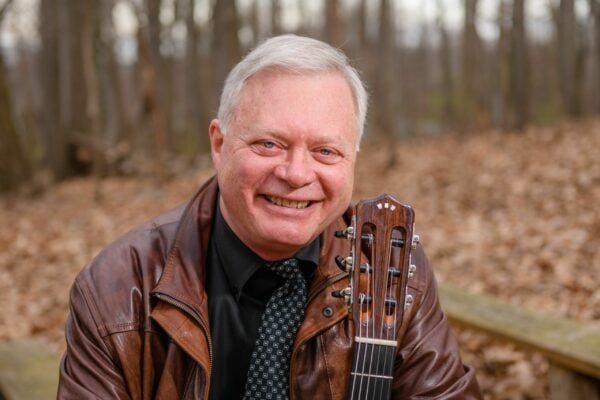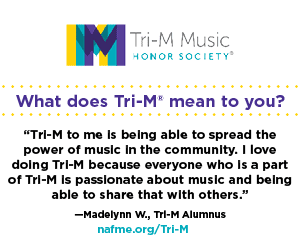/ News Posts / Setting Up an Effective Guitar Classroom
Setting Up an Effective Guitar Classroom
A Checklist
By NAfME Member Glen McCarthy, sponsored by NAfME Corporate Member Guitar and Accessories Marketing Association
Teaching Guitar Workshops (TGW) celebrates its 30th anniversary in 2025. Classroom teachers, whether guitarists or non-guitarists, who want to learn to teach classroom guitar can register by March 30 for just $30. After March 30 the regular registration rate for this four-day intensive workshop will be $399. On the first day participants will explore teaching ukulele, then the workshop continues with learning to play classical/finger-style, pick-style, simple chords, open chords, barre chords and more on guitar. Everyone taking an in-person TGW for the first time will receive a free guitar. Both in-person and virtual attendees will receive method books and a gift bag of guitar swag and accessories. For an additional $250 participants can earn three graduate credits. Both virtual and in-person workshops are available. For dates and locations go to discoverguitar.com/tgw. Read testimonials at the end of this article.
Guitars: The school should own a classroom set of matched instruments. Most veteran guitar teachers recommend nylon string (classical) guitars. for many reasons. Nylon String Guitars:
- Are much easier on beginner’s fingers
- Can play all styles of music
- Tend to break less frequently than steel string guitars
- Can be easier to repair than steel string guitars
Storage: Lockers and/or Racks. Both personal and school-owned instruments will need to be stored. Practical solutions include hanging the instruments on the wall, using a rack system, or using lockers.
Guitar Stand: A guitar stand for the instructor is useful for securing your guitar and allows you the freedom to move around the room without the instrument.
Podium: A platform or riser is something to consider; it will allow students to see you better as you model proper posture and technique.
Music Stands: One stand per student is optimal, however seating students two or three per stand can work. Stands that are shorter than standard music stands are available and will also allow you to observe the students right and left hands for quick assessments.
Footrest/Footstool/Supports: For proper playing position you need to elevate your left leg with the waist of the guitar resting on the leg. You want the guitar neck to have an upward angle of approximately 45 degrees; guitar footrests and guitar supports are designed for this purpose. Alternatively, you can use 4″x4″ deck posts cut into 10″ blocks or 2″x4″s cut into 6″ lengths fastened together to accommodate varying heights. Foam yoga blocks also work well.
Straps: Using guitar straps is another way to achieve good posture. Strap buttons can be purchased at your local music store. Installing the buttons is easy for your local guitar luthier. Classical guitar straps are also available, and do not require strap buttons.
Sound and Video System, Part 1: A sound system with inputs for a microphone (it will stress your voice trying to talk over 30 students playing guitar) and your guitar is recommended. It should also have an input for an audio source, such as an iPhone or Android phone, or be Bluetooth enabled. There are several downloadable apps worth checking out that can manipulate digital music to aid your teaching; for example, allow change the speed of a song without changing the pitch, or change the pitch and not the tempo of digital music.
Sound and Video System, Part 2: If you use electric guitars and/or a bass in class or performances, make sure you have plenty of guitar cables of various lengths. You will also need to have a ready supply of cables, adapters, and dongles for your smartphone, laptop, DVD/Video, metronome, or other devices.
A projector and screen or smartboard system are great ways to show your students exemplar performances of guitarists, and guitar related videos. There are many recordings available on sites such as YouTube and Vimeo.
Methods Books: Go to www.discoverguitar.com to find publishers who are GAMA members. This is a good start to identify guitar publishers and methods; you can also ask your local music merchant for recommendations. It is best to accumulate a variety of different books over time and pick and choose the exercises that support your curriculum.
Tuners: Clip-on headstock tuners are accurate and easy to use; they pick up the vibrations of the instrument and are not affected by ambient sound in the room. There are also several guitar tuner apps for smartphones available for students who have one.
Drum Machine: Rote practice is more fun with accompaniment. Consider adding a rhythm track to the daily practice routines in your classroom. Drum machines are available with pre-set beat patterns and styles in both “old school” physical form and smartphone apps. You can also find high quality backing tracks on YouTube.
Capos: If you will be playing contemporary music in class, you will likely need a classroom set of capos. Make sure you purchase the appropriate capo for nylon (flat fingerboard) or steel-string (convex fingerboard) guitar.
String and Fingerboard Maintenance: String Change Kit: peg head support block, string winder and string/wire cutter, needle-nose pliers, extra strings (1st for steel strings, 1st and 4th for nylon), bridge pin puller (for steel). Note: Many string winders have a slot that is to be used as a pin puller. If you are changing several strings, a “chuck” is available for a variable-speed reversible drill. There is a (specific for guitar) drill-type string-winder available.
Guitar Maintenance: Use sewing machine oil or liquid graphite to lubricate guitar tuners. Most classical guitars don’t have truss rods (most steel strings do). Have appropriate “allen wrenches” for truss rod adjustments, these usually come supplied with the guitar. Use your local music store as a resource to repair your instruments if you are uncomfortable “repairing” guitars. Damage to guitars should be repaired with wood glue not epoxy.
Replacement Strings: Negotiate with your local dealer to get the best possible prices for strings in bulk. Purchase numerous 4th and 1st strings for nylon string. High E & D are usually the first to break. New high E, B, and G nylon strings take several days to hold their pitch. On a steel string high E & D are the 1st to go.
Picks and Nail Care: Use standard size picks in medium to hard gauge. Thin picks are not recommended. For playing fingerstyle: to shape the nails, a glass nail file, nail clippers, 500 – 800 grit sandpaper (finishing paper). Classical guitarists have been known to use pieces of ping pong balls and super glue to replace a broken nail.
Staff paper: Both 5-line and 6-line (tablature) as well as blank chord grids are available commercially and can also be found on various websites.
Cleaning Hands and Instruments: Recommend that your students wash their hands before class especially after lunch. Think about pizza, French fries, and orange slices on the guitar strings.
Assessments: Develop performance-based rubrics that correspond to your curriculum. Consider including written/digital tests to assess student’s understanding of concepts. It will reinforce what they are playing.
A Mirror: A full-size mirror is a great way to reinforce your instruction, as students are able see themselves playing. They can easily see the adjustments and their posture and technique as you critique their performance.
Additional Instruments: Consider adding acoustic and/or electric bass, electric guitars, and other fretted instruments like ukulele, mandolin, dobro, and banjo. Don’t forget keyboards and percussion!
You Can Do It!!! You are a music educator. You can stay one step ahead of your guitar students. If you have a budding “Rock Star” in your class, use that student as a resource. There are numerous online guitar methods that are very useful. Teaching Guitar Workshops (TGW), cosponsored by GAMA, NAfME, and NAMM offers a four-day professional development opportunity to get you started and/or enhance your existing program. Summer of 2025, live/in-person classes will be offered in numerous locations as well as a virtual option. For more info go to discoverguitar.com/tgw.
Testimonials from past TGW participants:
“The TGW workshop was the most pivotal week of my teaching career. Not only was the door opened to a whole new world of available materials, I spent a week with two people who taught guitar full time in public schools! They had multi-level programs that gave students a creative outlet outside of traditional ensembles. I was transformed! . . . Thousands of students have come through my classes alone. Some play professionally with nationally known acts. Some have college degrees and are participating in every avenue of music imaginable. Some are active-duty military and send me videos of them playing guitar to their newborn children. All of this was made possible because I walked through the door of a Teaching Guitar Workshop.”—TGW participant
“The time I’ve spent with Teaching Guitar Workshops (TGW) has been incredibly valuable, both as a participant and later as a clinician and GAMA member. . . . I returned to the classroom with new confidence. The students were excited to be in guitar class, and I was able to engage them in ways I couldn’t before. . . . TGW has truly transformed my teaching, and I’m proud to be part of its continued growth.”—Robert Russell Pethel, TGW participant and clinician
Updated from February 17, 2022. Read past articles on guitar education.
About the author:
 For more than 30 years, Glen McCarthy has taught class guitar, required for all music education majors and guitar pedagogy at George Mason University. He also teaches at the Mason Community Arts Academy and is the facilitator of the ukulele and guitar workshops for the Veterans and The Arts Initiative at the Hylton Center in Manassas, Virginia. He has been a guest clinician and adjudicator at festivals, conferences, and workshops, both nationally and internationally. He is a past chair of the NAfME Council for Guitar Education, a past chair of the ASTA Guitar-in-the-Schools Committee, and presently executive director and clinician for Teaching Guitar Workshops.
For more than 30 years, Glen McCarthy has taught class guitar, required for all music education majors and guitar pedagogy at George Mason University. He also teaches at the Mason Community Arts Academy and is the facilitator of the ukulele and guitar workshops for the Veterans and The Arts Initiative at the Hylton Center in Manassas, Virginia. He has been a guest clinician and adjudicator at festivals, conferences, and workshops, both nationally and internationally. He is a past chair of the NAfME Council for Guitar Education, a past chair of the ASTA Guitar-in-the-Schools Committee, and presently executive director and clinician for Teaching Guitar Workshops.
Mr. McCarthy retired from Fairfax County Public Schools after 30 years at Robinson Secondary School where he developed a multi-level guitar program. Robinson was the first recipient of the Guitar & Accessories Marketing Association’s award to recognize innovative guitar programming in the United States. Under his direction, the Robinson Guitar Ensemble performed in numerous venues and was consistently awarded superior ratings at adjudicated festivals.
In 2014 from more than 32,000 nominees the GRAMMY Foundation® recognized Glen as one of the top ten music educators in the United States.
Interested in reprinting this article? Please review the reprint guidelines.
The National Association for Music Education (NAfME) provides a number of forums for the sharing of information and opinion, including blogs and postings on our website, articles and columns in our magazines and journals, and postings to our Amplify member portal. Unless specifically noted, the views expressed in these media do not necessarily represent the policy or views of the Association, its officers, or its employees.
Published Date
February 20, 2025
Category
- Ensembles
Copyright
February 20, 2025. © National Association for Music Education (NAfME.org)






